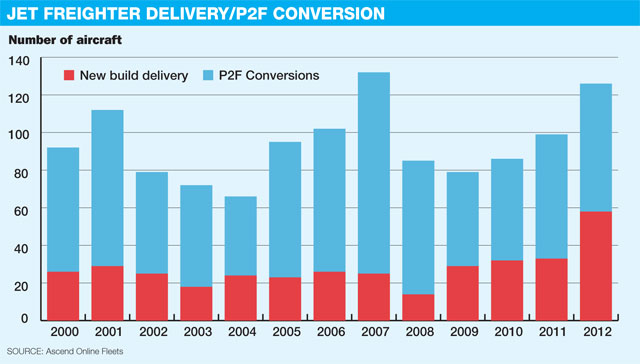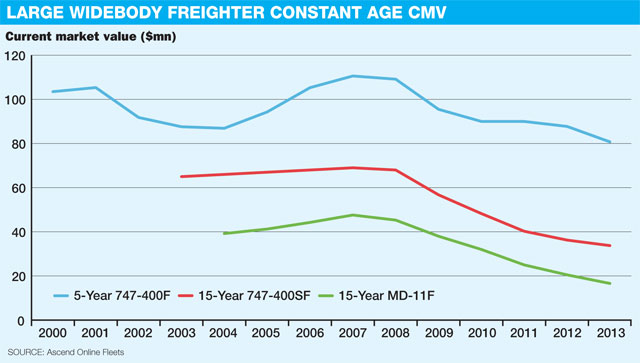Rob Morris, a senior analyst with Flightglobal advisory service Ascend, discusses the implications of continuing weakness in the air freight market
For some years now, the air freight market has been anaemic - despite having historically had higher growth than the passenger business.
With global economies struggling to recover from the downturn precipitated by the banking crisis of 2008, world trade remains weak and air freight traffic has suffered accordingly. Overall traffic volumes, as measured in revenue tonne-kilometres, have declined four times over the past 10 years, in 2008, 2009, 2011 and 2012.
Consequently, in 2012, traffic volumes were estimated to be only around 27% larger than those of 2000. That is an average annual growth rate of only 2% over the past 12 years. Back in 2000, Boeing's Commercial Market Outlook (CMO) predicted average freight traffic growth of 6.4% per annum.
If that had been achieved, the market would be around 65% larger than it is today. Boeing has tempered its growth expectations somewhat in the most recent CMO, predicting average annual growth of 5.4% over the next 20 years.
Airbus has a similar view, projecting 4.9% cargo traffic growth in their 2012 Global Market Forecast. However, each of these forecasts still predicts significantly stronger growth in the next 20 years than in the past 12 years. What if neither is correct and the trend we have seen since 2000 endures? In that case, by 2022, traffic volumes may be only around 20% greater than in 2012. If this pessimistic scenario comes true, then the impact on global freighter fleets and their values is potentially significant.

Since 2000, the number of jet freighter aircraft in service globally has remained almost unchanged, with the 1,522 aircraft in service at the end of 2000 growing by just seven units to 1,529 aircraft at the end of 2012.
However, as illustrated in the chart above, there have been big changes in the fleet mix over that time, with relatively more intermediate (e.g. Boeing 767) and large (e.g. Boeing 747) widebody aircraft now in service and a drop in the number of small (narrowbody) freighters. Thus, while the fleet size remains unchanged, capacity available from the fleet in service has increased by an estimated 40% since 2000.
The fleet itself has also churned significantly in the past 12 years. Only 36% of the freighter aircraft operating at the end of 2000 remained in service at the end of last year, with a total of 975 of those original aircraft either having been retired or placed into storage.
In the 2000-12 period, 362 new-build jet freighters were delivered, while a further 863 aircraft were converted from passenger to freighter (P2F) usage. The pace of these deliveries and conversions is illustrated in the chart below, with the volume suggesting a looming potential overcapacity as supply of "new" aircraft into the market increases at a time of static or decreasing traffic demand.

However, these statistics do not tell the whole story. A major element of the recent P2F conversions is for integrators such as FedEx, where the replacement of their older Boeing 727 fleet with converted Boeing 757s is expected to sustain around 18 conversions annually for the next few years. But while the integrators are also accepting some new-build freighters, more of these Airbus A330, Boeing 747-8, 767 and 777 aircraft are being delivered to major cargo airlines.
With a further 50 new-build aircraft and 57 P2F conversions forecast to enter the market in 2013 (although the latter comprise mostly narrowbody or intermediate widebody aircraft for integrators and regional cargo operators), and a 2.3% drop in year-to-date global freight traffic over 2012, a big capacity surplus seems to be developing.
This capacity surplus is being exacerbated by developments in the passenger widebody market as the fleet of larger widebody types continues to grow. Aircraft such as the 777-300ER, which can typically offer around 22-25t of cargo capacity in the belly hold, are facilitating more cargo capacity available at "marginal" pricing. Thus, marginal capacity continues to grow in the face of weakening demand.
This surplus is manifest in a number of ways. Utilisation of main deck freighter aircraft is declining - Cargolux's 747 fleet flew on average around 9% fewer hours in 2012 than in 2004. Although there are signs of market recovery in 2013, there is still further asset utilisation that could be achieved. Aircraft availability has increased, with around 115 main-deck freighters advertised for sale or lease in the most recent issue of Airfax.
While P2F conversions of narrowbody aircraft continue, conversions of 747-400 aircraft are presently moribund and no future conversions are scheduled, and 767 conversions are also slow. Part-out rates have also increased, with more than 500 main-deck freighter jets scrapped since the beginning of 2008.
The stored aircraft inventory, which is now over 350 units, remains significant although it has decreased from the highs of around 460 in 2009, largely as a result of the increase in scrap rates. The vast majority of these stored aircraft are greater than 20 years of age and in the current demand scenario, these are highly unlikely to ever return to service. In this context, only 12 of the 350 stored freighters have a next operator identified.
But among the younger aircraft, there are also some startling examples, including one 747-8F that Atlas Air cancelled prior to delivery, in addition to several young 747-400ERFs and -400Fs that will continue to exert pressure on the capacity balance.
As a result of this negative market pressure, widebody freighter values have recorded significant reductions over the past few years. As the chart below illustrates, in cash terms the value of a five-year-old 747-400F has declined by more than 25% since 2007, while the value of a 15-year-old converted 747-400SF is now less than 50% of the value of a 15-year-old aircraft six years ago. There has been similar pressure on values of the MD-11.

The market outlook is not bright. Forecasts by OEMs for future traffic growth appear optimistic. On the demand side, the global economic outlook remains challenging. High fuel prices continue to exert pressure on costs, allowing alternative surface transport options to become increasingly competitive. The increase in container ship capacity is making sea transport prices even more compelling, when speed is not a necessity. In the face of high fuel prices, the industry at present appears to be unwilling to pay the air freight premium for speedier delivery. Yet supply continues to increase, both through passenger widebody fleet growth and the continued delivery of new-build freighters. The implication for main-deck freighter values can only remain negative for now.
Source: Air Transport Intelligence news



















